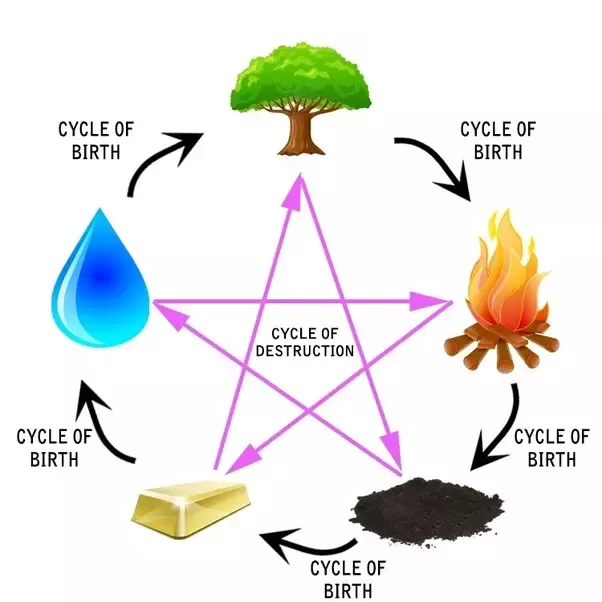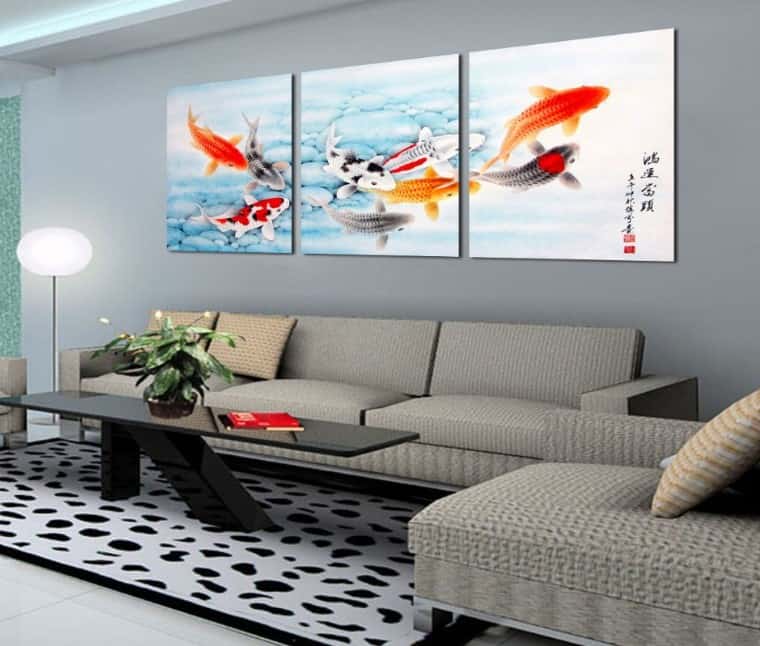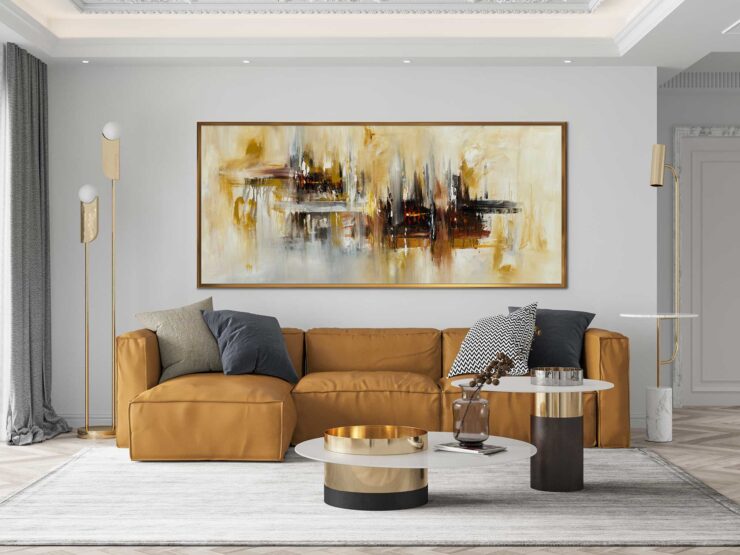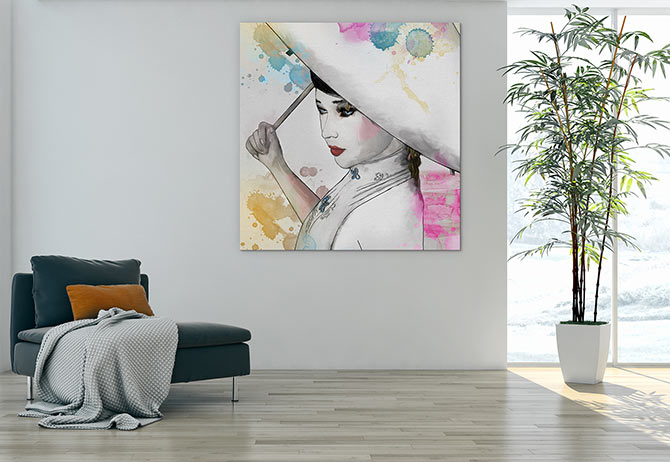Unveiling the essence of Feng Shui, one can perceive it as an art— the art of arranging spaces, nurturing harmony, and fostering positive energy. A significant and often overlooked facet of this art lies in our choice of wall adornments. The power of wall art in Feng Shui extends beyond aesthetics, shaping the energy dynamics of our homes and workplaces.
Expression of Elements in Feng Shui

The wisdom of Feng Shui is deeply interwoven with the concept of the Five Elements—Wood, Fire, Earth, Metal, and Water. Each of these elements symbolizes different aspects of life, energy, and the cyclical interplay of nature. Notably, wall art presents a perfect canvas to represent and harmonize these elements. Imagine a vibrant painting, embodying the energy of fire, gracing your living room wall. It may foster dynamism, passion, and conviviality within the space.
Expressing these elements is more than a mere aesthetic decision; it’s a strategic act of inviting specific types of energy into your space. A tranquil ocean scene encapsulates the water element, inviting calm and reflection, while an artwork of a lush green forest may symbolize the wood element, bringing growth and vitality. Thoughtfully chosen pieces, in alignment with the Five Elements, can enhance the Qi, or energy flow, in your environment, facilitating balance and well-being. Stone And Gray offer large canvas wall art South Africa if that is what you enjoy.
Choosing the Right Piece for Specific Areas
Stepping into the realm of Feng Shui, one realizes that every space holds a unique energy signature. This concept is encapsulated by the Bagua map, which assigns different life areas to different parts of your home or workspace. The key to using wall art effectively lies in understanding this spatial energy matrix. Visual pieces reflecting abundance, for instance, are best placed in the wealth area to reinforce the intention of prosperity.
The Bagua doesn’t only guide us to the best areas for placement but also helps determine the type of art that will be most beneficial. For example, the family area responds well to the imagery of lush trees, symbolizing health and growth, while the love and relationships area benefits from art that celebrates partnership and romance. Integrating it strategically with the Bagua principles strengthens the desired energy pattern, creating spaces that resonate with your life intentions.
Incorporating Feng Shui principles into your choice of wall art not only enhances the energy flow within your space but also aligns your surroundings with your life’s intentions and aspirations. By selecting artwork that resonates with the specific life areas identified by the Bagua map, you can create a harmonious and purposeful environment that supports your well-being and personal growth. For more information on Feng Shui practices in wall designs, discover fabulous wall art and all the different prints at Wallprint.
Color and Symbolism in Feng Shui Wall Art

Embarking upon the journey of color and symbolism in Feng Shui, we encounter an enthralling palette of meaning. Each color and symbol carries a unique vibration, profoundly impacting the ambiance and energy of a space. For instance, red – the color of prosperity and luck in Chinese culture – might be a fitting choice for artwork in your office or study area. Symbols like the lotus (representing purity and spiritual awakening) or the dragon (denoting power and success) further deepen the layer of Feng Shui significance.
While deciding on the right wall art, considering the colors and symbols harmonious with your intentions and the space’s purpose is paramount. An artwork depicting a serene mountain landscape in earthy tones might be suitable for the earth elements areas, such as knowledge and health sectors. Yet, the same piece might be less effective in a space governed by the fire element, where vibrant hues of red or orange might be more appropriate. Navigating the landscape of Feng Shui color and symbolism, one can make more informed and effective decisions.
Placement Techniques for Different Rooms
The process of positioning wall art is pivotal in Feng Shui, just as important as the choice of the artwork itself. For instance, hanging a beautiful painting of a sunset in the west-facing living room can harmonize with the energy of the setting sun. Simultaneously, artworks depicting water scenes are best avoided in bedrooms, as they may instigate emotional turbulence, disrupting the tranquility desired in such spaces.
It’s equally crucial to consider the height at which the artwork is placed. Artworks hung too high can lead to feelings of instability, while those positioned too low might create a sense of suppression. Ideally, the central point of the wall art should be at eye level, fostering a sense of balance and comfort. The placement, when mastered, can profoundly enhance the effectiveness of Feng Shui wall art.
Harmonizing Wall Art with Furniture and Decor

Harmony and balance, core principles of Feng Shui, should extend to the relationship between wall art, furniture, and decor. Integrating your wall art with the overall decor creates a seamless energy flow, fostering a sense of peace and coherence. For instance, an artwork of a vibrant sunrise might beautifully complement a room filled with warm-toned furniture, further enhancing the energy of illumination and awakening.
Yet, it’s essential to avoid the overpowering dominance of one element. An excess of earthy tones and imagery might result in a sluggish energy flow. In contrast, the strategic placement of artwork representing other elements can invigorate the balance, creating a more dynamic and harmonious environment. Successfully integrating wall art with furniture and decor becomes an enriching dance of balance, as each element in the space plays its part in the symphony of Feng Shui.
Creating a Balanced and Positive Atmosphere

The art gracing your walls holds the potential to shape the atmosphere of your space profoundly. A carefully chosen painting that resonates with your core values and intentions can inspire positivity, creating an environment that encourages your well-being and growth. For instance, artwork depicting nature can instill a sense of tranquility and connection, fostering an atmosphere conducive to relaxation and rejuvenation.
Yet, achieving balance is equally important. An overdose of vibrant, dynamic imagery might overstimulate the energy, leading to restlessness. Conversely, overly serene or melancholic art could induce lethargy. The magic lies in blending diverse types of wall art, each serving a unique purpose—some to inspire, some to soothe, and others to connect you with your aspirations. Together, they can create a balanced and positive atmosphere, nurturing your personal and professional life.
Final Reflections: The Artful Dance of Feng Shui
As our exploration concludes, we are left with a deeper appreciation of the influential role wall art plays within the sphere of Feng Shui. It goes beyond being a mere decorative item, becoming a strategic tool to shape and direct the energy flow within our spaces. With thoughtful consideration of elements, colors, symbolism, placement, harmony with decor, and personal preferences, it transforms into a catalyst for balance, prosperity, and positivity.

